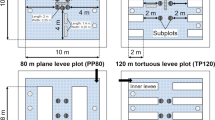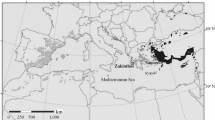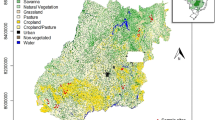Abstract
This study investigated ecological factors affecting species distribution and travertine deposition in an Italian site of the “Natura 2000” network. Vegetation plots were located along four streams in a prealpine valley (Valganna, Lombardy, Northern Italy). Five meso-scale variables (e.g. altitude, aspect and slope) and ten micro-scale variables (e.g. shading, plot position and soil accumulation) were recorded for each plot; in addition, travertine deposition was evaluated. The main floristic gradients extracted by DCA were related to topography, vegetation type and water availability. The occurrence of species groups in relation to environmental variables was analysed using Poisson regression. Amongst 15 environmental variables and six species, the variables showing the greatest relationship to travertine deposition were the length of the waterless period and substrate slope. Photosynthetic organisms had a minor role in travertine formation, mostly restricted to substrates with a shallow slope. The maintenance of a sufficient water flow is the most effective action in conservation plans for petrifying springs.
Riassunto
Il presente studio ha analizzato i fattori ecologici che influiscono sulla deposizione di travertino e sulla distribuzione delle specie, in un sito italiano della rete “Natura 2000”. Rilievi di vegetazione sono stati posizionati lungo quattro maggiori corsi d’acqua di una valle prealpina (Valganna, Lombardia, Italia Settentrionale). Cinque variabili a livello di micro-scala (es. altitudine, esposizione e pendenza) e dieci variabili a meso-scala (es. grado di ombreggiamento, posizione del plot e accumulo di suolo) sono state rilevate per ciascun rilievo; in aggiunta è stata valutata anche la deposizione di travertino. I principali gradienti floristici ottenuti dalla DCA sono correlati alla topografia, al tipo di vegetazione e alla disponibilità di acqua. La distribuzione di gruppi di specie è stata interpretata tramite le variabili ecologiche considerate impiegando la regressione di Poisson. Tra le quindici variabili ambientali e le sei specie analizzate, i fattori che hanno evidenziato un maggiore legame con la deposizione di travertino sono risultati essere il periodo di siccità e la pendenza del substrato. Gli organismi fotosintetici sembrano avere un ruolo minore nella formazione di travertino, circoscritto soprattutto ai substrati con minor pendenza. Il mantenimento di un soddisfacente flusso d’acqua viene considerato come la più importante azione nei piani di gestione delle sorgenti petrificanti.



Similar content being viewed by others
References
Aeschimann D, Lauber K, Moser DM, Theurillat J-P (2004) Flora alpina. Zanichelli, Bologna
Agence de l’Eau (1997) Biologie et écologie des espèces végétales proliférant en France, synthèse bibliographique. Les études des agences de l’eau, n° 68. Ministère de l’Aménagement du Territoire et de l’Environnement Direction de l’Eau, Paris
Aleffi M, Schumacker R (1995) Check-list and red-list of the liverworts (Marchantiophyta) and hornworts (Anthocerotophyta) of Italy. Flora Medit 5:73–161
Bell PR, Lodge E (1963) The reliability of Cratoneuron commutatum (Hedw.) Roth as an ‘indicator moss’. J Ecol 51:113–122
Buffa G, Miserere L (1997) Note sulla presenza di comunità vegetali dell’Adiantetea in Valle d’Aosta. Rev Valdôtaine Hist Nat 51(suppl):211–217
Caudwell C, Lang J, Pascal A (2001) Lamination of swampy-rivulets Rivularia haematites stromatolites in a temperate climate. Sediment Geol 143:125–147
Chen J, Zhang DD, Wang S, Xiao T, Huang R (2004) Factors controlling tufa deposition in natural waters at waterfall sites. Sediment Geol 166:353–366
Chytrý M (2001) Phytosociological data give biased estimates of species richness. J Veg Sci 12:439–444
Cohn F (1864) Über die Entstehung des Travertin in den Wasserfällen von Tivoli. Neues Jahrb Miner Geol Paleontol 40:580–610
Conti F, Abbate G, Alessandrini A, Blasi C (eds) (2005) An annotated checklist of the Italian vascular flora. Palombi, Roma
Cortini Pedrotti C (2001) New check-list of the mosses of Italy. Flora Medit 11:23–107
Craw RC (1976) Streamside bryophyte zonations. NZ J Bot 14:19–28
Deil U (1994) The class Adiantetea in the Mediterranean area—an approach from vegetation history and community evolution. Colloq phytosoc 28:241–258
Dierßen K (2001) Distribution, ecological amplitude and phytosociological characterization of European bryophytes. Bryophyt Bibl 56:1–289
Dodds WK, Gudder DA (1992) The ecology of Cladophora. J Phycol 28:415–427
Drehwald U, Preising E (1991) Die Pflanzengesellschaften Niedersachsens. Moosgesellschaften. Natursch Landschaftspfl Niedersachsens 20(9):1–204
European Commission—DG Environment (2005) Interpretation manual of European Union habitats. EUR27
Finlay JC (2003) Controls of streamwater dissolved inorganic carbon dynamics in a forested watershed. Biogeochemistry 62:231–252
Friesen A, Bini A, Uggeri S (1994) Il carsismo della Valganna: caratteristiche ed evoluzione paleoambientale. In “I depositi Plio-Quaternari e l’evoluzione del territorio varesino”. Guida alle escursioni, Riunione autunnale Gruppo Nazionale Geografia Fisica e Geomorfologia CNR, Varese, pp 151–161
Gauch HG (1982) Noise reduction by eigenvector ordinations. Ecology 63:1643–1649
Gimingham CH, Birse EM (1957) Ecological studies on growth-form in bryophytes: I. Correlations between growth-form and habitat. J Ecol 45:533–545
Giovi E (2005) Gli Habitat della Direttiva Europea in Italia. In: Blasi C, Boitani L, La Posta S, Manes F, Marchetti M (eds) Stato della biodiversità in Italia. Palombi, Roma, pp 220–237
Glime J (1970) Zonation of bryophytes in the headwaters of a New Hampshire stream. Rhodora 72:276–279
Golubić S (1967) Algenvegetation der Felsen. Eine ökologische Algenstudie im dinarischen Karstgebiet. Die Binnengewässer XXIII. E. Schweizerbart’sche Verlagsbuchhandlung, Stuttgart
Hothorn T, Hornik K, Zeileis A (2006) Unbiased recursive partitioning: a conditional inference framework. J Comput Graph Stat 15:651–674
John DM, Whitton BA, Brook AJ (eds) (2002) The freshwater algal flora of the British Isles. Cambridge University Press, Cambridge
Jongman RHG, ter Braak CJF, van Tongeren OFR (1987) Data analysis in community and landscape ecology. Pudoc, Wageningen
Kauff F, Büdel B (2005) Ascoma ontogeny and apothecial anatomy in the Gyalectaceae (Ostropales, Ascomycota) support the re-establishment of the Coenogoniaceae. Bryologist 108:272–281
Kaufman L, Rousseeuw PJ (1990) Finding groups in data: an introduction to cluster analysis. Wiley, New York
Merz-Preiß M, Riding R (1999) Cyanobacterial tufa calcification in two freshwater streams: ambient environment, chemical thresholds and biological processes. Sediment Geol 126:103–124
Miserere L, Buffa G (2002) Contributo alla conoscenza della vegetazione delle sorgenti calcaree in Valle d’Aosta. Braun Blanquetia 31:27–32
Nimis PL (1993) The lichens of Italy. Monografie Mus Reg Sci Nat Torino 12:1–897
Økland RH (1990) Vegetation ecology: theory, methods and applications with reference to Fennoscandia. Sommerfeltia Suppl 1:1–233
Page CN (1997) The ferns of Britain and Ireland. Cambridge University Press, Cambridge
Pentecost A (1987) Growth and calcification of the freshwater cyanobacterium Rivularia haematites. Proc R Soc Lond B Biol 232:125–136
Pentecost A (1990) The algal flora of the travertine: an overview. In: Herman JS, Hubbard DA (eds) Travertine-Marl: stream deposits in Virginia. Publication 101 of Virginia Division of Mineral Resources, Charlottesville, pp 117–127
Pentecost A (1995) The quaternary travertine deposits of Europe and Asia Minor. Quat Sci Rev 14:1005–1028
Pentecost A (1996) Moss growth and travertine deposition: the significance of photosynthesis, evaporation and degassing of carbon dioxide. J Bryol 19:229–234
Pentecost A (1998) The significance of calcite (travertine) formation by algae in a moss-dominated travertine from Matlock Bath, England. Arch Hydrobiol 143:487–509
Pentecost A (2000) A note on the stable carbon isotope composition of bryophytes in calcareous aquatic habits and its relationship to carbon dioxide assimilation. J Bryol 22:13–15
Pentecost A (2003) Taxonomic identity, ecology and distribution of the calcite-depositing cyanobacterium Phormidium incrustatum (Oscillatoriaceae). Cryptogam Algol 24:307–321
Pentecost A (2005) Travertine. Springer, Berlin
Pentecost A, Viles HA (1994) A review and reassessment of travertine classification. Géogr Phys Quat 48:305–314
Pentecost A, Zhaohui Z (2002) Bryophytes from some travertine-depositing sites in France and the U.K.: relationships with climate and water chemistry. J Bryol 24:233–241
Pentecost A, Zhaohui Z (2006) Response of bryophytes to exposure and water availability on some European travertines. J Bryol 28:21–26
Peres-Neto PR, Jackson DA (2001) How well do multivariate data sets match? The advantages of a Procrustean superimposition approach over the Mantel test. Oecologia 129:169–178
R Development Core Team (2008) R: A language and environment for statistical computing. R Foundation for Statistical Computing, Vienna. http://www.R-project.org
Ritschard G (2006) Computing and using the deviance with classification trees. In: Rizzi A, Vichi M (eds) Compstat 2006—proceedings in computational statistics—17th symposium, Rome, Italy. Physica-Verlag HD, New York, pp 55–66
Rizzi Longo L, Poldini L, Goia F (1980) La microflora algale delle pareti calcaree del Friuli-Venezia Giulia (Italia nord-orientale). Studia Geobot 1:231–263
Rousseeuw PJ (1987) Silhouettes: a graphical aid to the interpretation and validation of cluster analysis. J Comput Appl Math 20:53–65
Souza-Egipsy V, Del Cura MAG, Ascaso C, De Los Ríos A, Wierzchos J, González-Martín JA (2006) Interaction between calcite and phosphorus in biomineralization processes in tufa carbonates. Internat Rev Hydrobiol 91:222–241
Struyf A, Hubert M, Rousseeuw PJ (1996) Clustering in an object-oriented environment. J Stat Softw 1:1–30
Vitt DH, Glime JM (1984) The structural adaptations of aquatic Musci. Lindbergia 10:95–110
Zechmeister H, Mucina L (1994) Vegetation of European springs: high-rank syntaxa of the Montio-Cardaminetea. J Veg Sci 5:385–402
Acknowledgments
The authors are grateful to Dr. Sandro Uggeri for unpublished data, to the Regional Park “Campo dei Fiori” for financial support and to S. Pierce for the correction of the English text. The research was part of the Life Natura 2000 Project “Chirotteri, habitat calcarei e sorgenti petrificanti nel Parco Campo dei Fiori” (LIFE00NAT/IT/7139).
Author information
Authors and Affiliations
Corresponding author
Additional information
Responsible editor: Sonja Wipf.
Rights and permissions
About this article
Cite this article
Brusa, G., Cerabolini, B.E.L. Ecological factors affecting plant species and travertine deposition in petrifying springs from an Italian ‘Natura 2000’ site. Bot. Helv. 119, 113–123 (2009). https://doi.org/10.1007/s00035-009-0064-2
Received:
Accepted:
Published:
Issue Date:
DOI: https://doi.org/10.1007/s00035-009-0064-2




